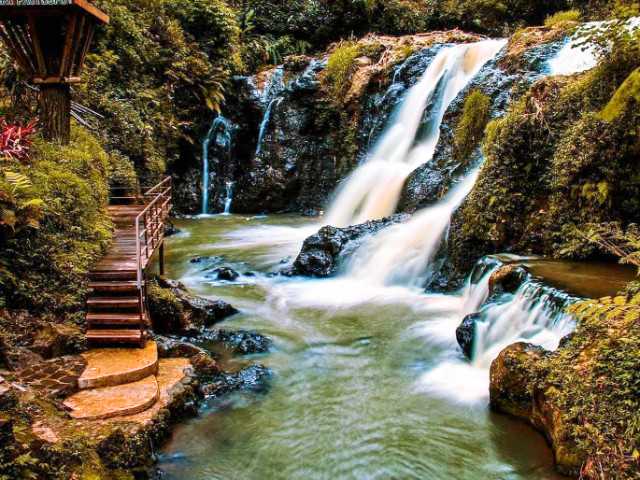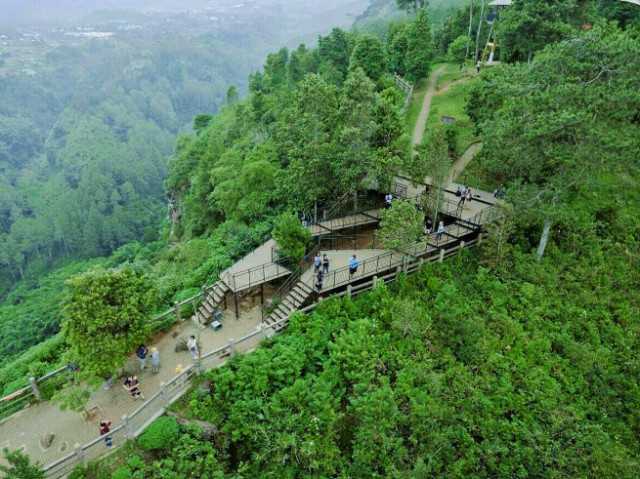TAMAN HUTAN RAYA IR. H. DJUANDA
In the hills around eight kilometres north of Bandung a long narrow swathe of National Forest, Taman Hutan Raya Ir. H. Djuanda, hugs a serpentine river valley and offers an enjoyable five-kilometre walk with waterfalls and fascinating historical bunkers to explore—a breath of fresh air from Bandung’s congested traffic.
The park (also known as TAHURA or Juanda Forest Park) covers an area of almost 600 hectares from Maribaya just outside of Lembang in the north, to Dago in the south, with a mix of vegetation including pine plantations and secondary natural rainforest. This conservation area is named for Raden Djuanda Kartawidjaja, who was Indonesia’s final Prime Minister before the abolition of the post to allow for greater power to be exercised by the President (his face can also be seen on the 50,000 rupiah note). Within the park a monument and a small museum are dedicated to him.
(1.1 Taman Hutan Raya Ir. H. Djuanda)
Entrances at either end of the National Forest are connected by a single path. The easiest hiking option is to start in the north at Maribaya and walk in a southwesterly direction towards Dago. This means your hike will begin at just over 1,100 metres above sea level and descend to around 950 metres presenting you with a gentle downhill slope for most of the walk, of course if you fancy a bit of cardio (or your driver misunderstands, like ours), start at the opposite end. The path is straightforward and easy to follow if you are heading downhill, but in the uphill direction, a couple of unsignposted forks can be confusing (the signage is broken and has not been repaired).
Tahura From the Dutch Colonial Era
This forest park has been built since the days of the Dutch colonial government, precisely in 1912. At the beginning of its construction the place was named after the protected forest of Mount Pulosari. This forest area was opened and pioneered together with the excavation of the Cikapundung river tunnel.
The Government of the Republic of Indonesia took over management when Indonesia was independent. Since then the region has also been developed by the governor of West Java at that time. This forest area began to be pioneered as a tourist attraction titled the Botanical Gardens in 1963 and this year also Ir. H.
Juanda passed away. To commemorate the services of Ir. H. Juanda, this forest park is called the Recreation Botanic Garden Ir. H. Juanda. As a protected forest area, plants from various regions began to be planted here. Only on August 23, 1965, the Governor of West Java inaugurated this Botanical Garden / Forest.
Three Tahura Gates
Tahura has a lot of tools to explore. Natural scenery, history and sports can be done by tourists who visit here.
There are several gates that can be used as a starting point for exploration. Three main gates are in the Dago Pakar area, one gate in Maribaya, and several small gates for separate objects. This separate object is still in the management of the temple but there is no canal access to get there.
Various Activities Accompanied by the Beauty of Nature Juanda Forest Park
In this park itself, visitors can enjoy the beautiful natural treats and shady trees. With an area of land that stretches from dago to lembang, various activities can be done here. The atmosphere of a typical park with great forest, is perfect for visitors who are happy with adventure.
Physical activity, out bound, hiking, biking, exploring history and camping can be done. For more details, here are some activities that can be done in Juanda Forest Park.
Ticket prices Juanda Forest Park
To be able to enter and get around every tourist is charged a ticket fee for Tahura Juanda. Ticket prices Djuanda Forest Park Rp. 15,000.
Other costs are a parking fee of IDR 5,000 for cars, IDR 3,000 for motorbikes and IDR 15,000 for buses.
Opening hours Tahura Djuanda
Djuanda Forest Park is open every day from 8:00 to 18:00.
Attractions & Activities Forest Park Djuanda
Various activities can be done in the Forest Park Djuanda. Activities that are generally theme of nature adventure. Like hiking in a cave, Treking, or exercising. Some activities can also be done by children. Here are some of them.
1. Dutch Cave
Dutch caves are estimated to be no less than 111 years old. When tourists enter the Cave, the cold will immediately be felt. This cave consists of three interconnected passageways. On the left wing of the Cave there are prisoners of war cells and logistical storage.
The cell door is still left as the original and tourists can enter the room. On the right wing of the cave there is a narrow alley that ends at the stairs used to lurk in ancient times.
The road in the cave is quite flat and the cave walls still have rusty iron like the original. Be sure to wear clothes that are quite thick and flashlight because this cave is very dark.
(1.2 Dutch Cave)
2. Japanese Cave
300 meters from the Dutch Cave, the Japanese Cave has four entrances and two guard holes. It is said that the Japanese Cave was built by forced labor or better known as romusha.
This cave was used by the Japanese to protect themselves from allies and to become a place for military and logistical weapons storage. Inside this cave there are small caves that were used as interrogation sites, there are also prisons, hiding places and storage holes.
This cave still retains its original form with its base and walls still in the form of earth and rock. Tourists are shocked by a group of bats that are lodged in the ceiling of the Cave. Japanese caves are more stuffy and darker than Dutch caves.

(1.3 Japanese Cave)
3. Waterfall (Curug)
There are at least three famous waterfalls in Tahura Djuanda, including Curug Dago, Omas Waterfall, and Lalay Waterfall. Curug Dago has a height of 12 meters, in this place found two inscriptions from the King of Thailand.
While the Omas waterfall is better known as the Maribaya waterfall because of its location in the Maribaya tourist area, the height of the waterfall is around 30 meters.
Finally, the Lalay waterfall has the same waterfall height as the Omas waterfall, but the location of this waterfall is slightly hidden between the valleys. On the side of the waterfall there is a cave where the bats nest, also called the Lalay Cave.

(1.4 Maribaya Waterfall)
4. Museum Ir. H. Djuanda
The museum was built as a tribute to a national hero figure Ir. H. Djuanda. This museum measures approximately 8 x 10 meters. Inside the museum there are various kinds of awards received by Ir. H. Djuanda.
Starting from the award plaque from the Indonesian government and foreign countries, to medals, buttons, and wings from various countries such as Malaysia, Russia, and Thailand. In this room there is also a large photo of Ir. H. Djuanda. In addition there is a collection of herbarium and animal offsets and ancient artifacts.
(1.5 Museum Ir. H. Juanda)
5. Keraton Cliff
Witness the beautiful sunrise and sunset on this cliff. To enter the Tebing Keraton, a separate ticket and a one-day ticket to Tahura apply. Make sure you are in the right time to be able to enjoy it and be careful because access to this place is very uphill and steep.

(1.6 Keraton Cliff)
6. Deer Breeding
In this place tourists will be treated to various information about the deer including the benefits of the deer itself. Not many people know if a deer has benefits in every part of its body. In deer breeding, tourists can naturally feed the deer.
(1.7 Deer breeding)
Facilities of Djuanda Forest Park
There are many small huts for tourists who want to sit or rest. For those who want to stay overnight there are also inns, guesthouses, guest houses, and campsites. For those who like to exercise there are special tracks for jogging and cycling.
Tahura Djuanda is also equipped with special facilities for children such as playgrounds, paintball areas and play ground. There is also an outbound area that can be enjoyed by children and adults. Other supporting facilities are a fairly clean toilet and mosque.
Transportation to Djuanda Forest Park
It is not difficult to find Djuanda Djuanda Forest Park because this place is already famous and easily accessible. There are at least two public transportation that can bring tourists to visit this place.
Although you have to add a little walk. The first angkot is Ciroyom-Ciburial, this angkot is cream-green. This angkot can be found on Jalan Simpang Dago, please be a little patient because this angkot will usually not run before it is full of passengers.
The second angkot is orange with Caringin-Dago direction, this angkot can be found in Jalan Suci and Jalan Cikutra. Travelers just need to notify public transportation drivers to be transported to Tahura Djuanda or Dago Pakar Forest. Tourists usually have to walk around 500 meters to 1 kilometer.
Reminder
Be careful carrying luggage, because this forest as well as a conservation place is not uncommon for monkeys who live freely to approach tourists to take food or goods left by tourists.
Don't forget to bring a torch or a flashlight if you want to enter the Dutch Cave and the Japanese Cave. Be careful about the price discrimination applied by flashlight tenants and guides around the Cave.
Finally, be sure to be on the lookout for lines or other markers around the Djuanda Forest. Not infrequently the trunk of an old tree broken and fell. Because of that, usually the watchdog and guards of the Djuanda Forest have placed boundaries around old trees so that tourists do not approach the place.
Address & Location of Djuanda Forest Park
Djuanda Forest Park is located at the address of the Tahura Complex Ir. H. Djuanda No.99, Dago Pakar, Ciburial, Cimenyan, Bandung, West Java 40198.
Question :
1. What interesting things are in Djuanda Forest ?
2. What transportation is suitable for heading to the Djuanda forest seen from the text above?
3. What is the difference between Dutch Cave and Japanese Cave?
4. What items that must be taken to Djuanda Forest?
5. When the Djuanda forest was created?
Question :
1. What interesting things are in Djuanda Forest ?
2. What transportation is suitable for heading to the Djuanda forest seen from the text above?
3. What is the difference between Dutch Cave and Japanese Cave?
4. What items that must be taken to Djuanda Forest?
5. When the Djuanda forest was created?
No comments:
Post a Comment